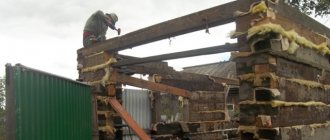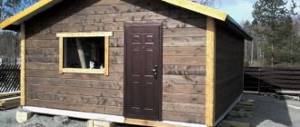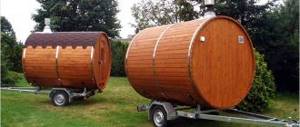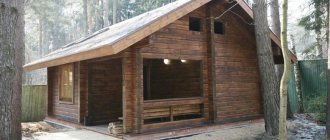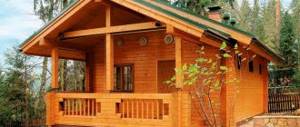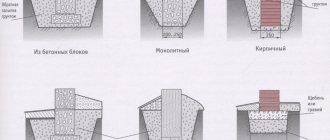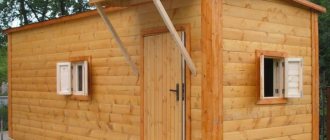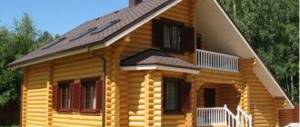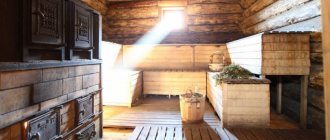A bathhouse in a private area is a functional place for recreational water treatments and family recreation.
An original and fresh solution for a suburban area located near a natural reservoir is a water bath. Modern construction technologies make it possible to quickly and efficiently erect such structures without causing damage to water sources.
Features of the construction of water baths
If the owner of the site has made the right decision to build a bathhouse on a pontoon, it is important to consider the following factors when developing a detailed design:
- It is prohibited to build water baths in environmental and protected areas. According to current legislation, such zones can occupy an area of 55 to 500 meters.
- The construction of a floating structure is permitted in cases where wastewater will be discharged beyond the established boundaries of the zone or the design provides for the additional use of septic tanks.
- When constructing a bathhouse on a private reservoir, it is necessary to provide the main method of wastewater treatment.
Important! When arranging a building on an artificial reservoir, which is private property, no permitting documentation is required.
Features of an exclusive floating steam room
Few people do not like outdoor recreation. It’s not for nothing that someone said: “The nerves are calmed by a delicious barbecue, fragrant cognac and your favorite little man, and the body is healed by soft steam and herbal decoction!” I would also add that the body is given good health, in addition to steam and decoction, by a biting broom and cold water.
Therefore, I recommend combining business with pleasure in order to please not only the soul, but also the body. For example, visiting a floating steam room is a great idea! Oh, stop. The peasant is for women, and the young lady is for men.
Concept
A floating bathhouse is a mobile structure erected on special prefabricated berths, for the construction of which pontoons are used. They are easy to assemble and disassemble, which allows the steam room to “travel” along the entire river or lake. In addition to the presence of pontoons, a floating steam room is in many ways similar to an “earth” bathhouse.
Components
Several centuries ago, the bathhouse was a tiny room consisting of one room. It would seem, how can one relax comfortably in such a miniature building? As you know, our forefathers did this very well. “Russian fun”, which both heroes and young ladies enjoyed in the bathhouse, are known throughout the world!
For example, after taking a steam bath, women and men ran naked into the street and dived into a snowdrift or an ice hole. Nowadays, of course, this is also practiced, but only in winter, since finding snow in autumn, spring and summer is problematic, and not everyone has the opportunity to build a bathhouse by the river.
Pool? Font? Barrel? Yah. This is completely different. But, as you know, Russian people are cunning. Not so long ago, wonderful structures appeared - floating baths. You can dive into cold water all year round! One room on the raft was not enough, of course. Today, water baths include the following required premises:
- steam room, which has a comfortable shelf;
- a terrace with a canopy, on which there is a table, chairs, and a barbecue;
- a bathroom with a shower stall, sink, and toilet;
- dressing room, which contains a bench, a wardrobe, a shoe stand and hooks for clothes, bags, etc.
Floating bathhouse on barrels
In addition, the owners of bathhouses on the water equip their “treasure”, which, to be honest, brings considerable income, with other premises:
- a comfortable and presentable relaxation room with a jacuzzi;
- ergonomic and aesthetic diving tower;
- luxurious kitchen and fashionable bar;
- landscaped sunbathing area.
Of course, if you wish, you can create something exclusive. The main thing is imagination! Don't be lazy. Believe me, you will not regret it, because as a business, a floating sauna is incredibly profitable. After all, the Russian people are greedy for fun.
What else? Safety. It’s difficult to call an “earth” bathhouse safe, and even more so a steam room on water. Therefore, “on board” you need:
- durable guardrails designed to prevent accidental falls;
- high-quality and charged fire extinguishers;
- life jackets and rings;
- qualified sober rescuers;
- first aid kit.
Before you start manufacturing a particular structure for a bathhouse, you need to consult with highly qualified specialists in order to avoid unpleasant situations.
The design of a floating bath, its advantages
Often, a floating bathhouse differs from its land-based counterpart. The differences lie in the design itself, as well as in the technology of constructing the foundation and body.
Stationary baths are erected on pile, columnar and strip foundations. The following types of pontoons are used for the construction of floating baths:
- Made of wood. A popular version of the pontoon, which is used in areas with harsh winters and hot summers. It is more suitable for reservoirs prone to freezing in winter.
- Made of plastic. This type of pontoon is most common and is recommended for use in areas with a temperate climate - mild winters and warm summers. The plastic pontoon is lightweight, but at the same time resistant to extreme loads.
- Made of metal. Factory or homemade design, which is characterized by high cost and demanding maintenance. The metal pontoon needs thorough cleaning and regular painting.
The walls of a stationary bath are made of natural lumber, brick or wall blocks. Most often, a floating sauna is built from wood or using frame technology.
Floating baths, like stationary buildings, have many advantages, the main of which include:
- practicality;
- durability;
- frost resistance;
- wear resistance;
- attractive appearance;
- comfort;
- functionality;
- ergonomics;
- affordable price.
There are no significant drawbacks to such structures, the only thing is that it is difficult to use such a bathhouse in the winter on a frozen reservoir.
Construction of a bathhouse
Construction of a floating structure
When the pontoon is made, you can proceed to the construction of the bathhouse itself. Here everything is basically the same as in the land version, but it is better to use materials that have as little weight as possible. For example, the frame of a bathhouse can be made not from oak logs, but from metal profile pipes, which are then covered with clapboard. Or you can keep it simple and use a ready-made version of the bathhouse, which can simply be assembled on a pontoon.
At this point, the issue of making a floating bathhouse can be considered considered. Of course, this is only a general description, but you can get an idea of the essence of the work and its general principles.
The following articles will help you get the job done:
- How to cover a bathhouse with clapboard.
- How to make shelves in a bathhouse.
- How to install a stove in a bathhouse with your own hands.
- How to make doors to a bathhouse with your own hands.
Detailed design development
Before the start of construction work, a standard design for the future structure is developed, in which the following parameters must be taken into account:
- total area and capacity of the bathhouse;
- pontoon type and wall materials;
- drainage features;
- average monthly air temperature;
- technical characteristics of the reservoir.
For ease of implementation, it is recommended to choose a simple design of a medium-sized bathhouse with a small veranda, a combined washing room and steam room.
After preparing the project, you can begin installing the pontoon and assembling wall structures.
Unusual baths
The bathhouse has long and firmly entered into our lives, not only as a place where you can relieve stress and improve your health. For modern people, a bathhouse with a steam room near the water has already become the same attribute as a car or a country house or apartment. And in most cases, authors and customers try not to limit themselves to a boring box or extension in the apartment in order to put their whole soul into it and please their friends and family with the originality of the design.
How to design a bathhouse
The most original and unusual baths are always built from wood. Firstly, this is the tradition and vast centuries-old experience of building a bathhouse on the ground, next to nature and water. Secondly, wood is rightly considered the most convenient material for any building, especially since it is impossible to make a real steam room from materials other than wood.
What types of wooden baths are there? There are good and bad, there are much fewer ugly buildings in nature, because even when building the simplest hewn bathhouse from timber or round logs, the craftsmen put so much imagination and soul into it that it would be hard to call it ugly.
The structures can be roughly divided into main groups of baths:
- Huts stylized with antique and folk motifs, standing by the water or at the edge of the forest;
- Complex in shape, with an intricate design, a bathhouse made of timber for a country holiday on the water, in nature, is often more than just a building with a steam room. These types of baths are very popular for outings into nature or to the water for a whole weekend;
- A separate category can be considered types of baths for relaxing by the water - on a river, lake or even the sea. The water bath is considered a classic place for a Russian bath; this particular type of relaxation is especially popular among lovers of relaxation and winter swimming in water;
- Urban options for an apartment are most often utilitarian, compact, but no less effective and often with an unusual design. A bathhouse in an apartment has long ceased to be something exotic; rather, it is an example of how the simplest things can be used for health benefits.
- The most elaborate and unusual designs, which were clearly not built for the sake of a beautiful picture, but are able to amaze the imagination with their structure and design.
In addition to those listed, there are many buildings that are difficult to attribute to any of the groups; they are interesting and unusual, sometimes they look like a joke, but for the most part these are real baths in which you can have a great steam bath and relax by the water, despite their unusual appearance.
Wooden baths
The possibilities of using wood in the design and construction of steam rooms are almost unlimited, even in an apartment. At the same time, it is often difficult at first glance to even understand that in front of you is a bathhouse made of timber or a residential building.
Saunas made of timber and logs
Most often, these types of baths are either simplified to a log house, reminiscent of an old hut from a Russian fairy tale, or built on a grand scale in the most bizarre forms. The simplest would be a bathhouse made of timber, specially treated and profiled material with a cross-section of at least 150x150 mm. From such material you can build as complex and beautiful structures as you like, even for an apartment; they will all be strong and durable.
Buildings in the form of barrels, various figures or unusual piles look interesting.
Unusual design solutions of the structure force the paired rooms to be designed accordingly in the same unusual shapes and bends.
A bathhouse made from debarked and rounded logs, especially near the water, looks somehow more exotic and brighter. But in construction it is much more difficult, since it is formed using old techniques for connecting log houses. If you wish, you can always build something unusual with pronounced antique features. Against their background, a bathhouse made of timber looks somehow too ordinary and boring.
Unlike timber, a log vault requires a lot of additional protective and thermal insulation measures. But in design and expressiveness, the log version looks more picturesque, especially if it stands somewhere near the water, on the edge of a pine forest.
Designs for recreation on the water
A water bath is more unusual for our perception. Most often, the purpose of installing a building in close proximity to the shore is the so-called contrast swimming in cold water. According to the old Russian method, you need to run from the hot steam room and plunge into soft lake or river water. After such stress in cold water, the body seems to acquire new reserves of strength and energy. Not everyone can run to free water and not get killed on a slippery clay or muddy bank. Therefore, a water bath is taken as far into the water as possible or special wooden paths are built for access to clean water.
For example, in Finland there is a dugout bathhouse with an exit directly into the water of the lake. In terms of popularity, such a bathhouse is not inferior to modern saunas, and, interestingly, it has been smoking near the water since 1906, for more than a hundred years.
Such buildings near the water can be modular, in the form of mobile houses, containers or even barrels. They are easy to bring and install near the water, at the beginning of the season, in your favorite place in the river or bay.
The desire to go as far from the shore as possible has grown into a new form of water bath. In fact, this is no longer a self-propelled craft, on which a wooden house with a stove and a pipe is installed. This approach makes it possible to be closer to clean water, away from mosquitoes and coastal vegetation. It is clear that there are a great many options for building for water recreation, with cauldron-shaped baths and antique Japanese water barrels.
Relaxing on the water in such an unusual bathhouse requires extremely stringent fire safety measures, because a fire, especially at a distance from the shore, can lead to fatal consequences within a few minutes.
Bathhouse in the apartment
In trying to adapt a bathhouse for an apartment, a city dweller turned out to be no less inventive than those who like to relax in a steam room in nature. But, unlike in rural areas, where there is a supply of water and a place to jump out in case of fire, a ignited steam room in an apartment can destroy not only the owner’s home, but also the neighbors’ apartments.
The advantages of such pairs are obvious:
- You can steam your bones and muscles in your apartment at any time of the day or night; it’s much more convenient than wasting a lot of time traveling out of town to a dacha or a public steam room;
- The apartment option is an ideal means for preventing rheumatism and combating autumn colds;
- Having your own steam room in the apartment is a guarantee of hygiene and cleanliness.
Modern bathhouses for apartments are almost always made to order by specialized companies or purchased as ready-made kits. Branded designs are much safer and more reliable for an apartment, given the fact that heating air and steam using electric heaters in such a bath always requires very reliable wiring and protection against electric shock in water.
Most often these are box-shaped structures made of wood, some of them resemble an old telephone booth, but the external appearance and design of such options do not spoil the decor of the apartment. Most often, for reasons of convenience, baths are placed as close as possible to the water source - near the bathtub or shower in the apartment.
It’s rare, but you can still find interesting bathhouse designs - homemade ones for an apartment, designed for a couple of people. Despite all the inconveniences, their creators are happy to use the steam room in their own apartment. Some of them can even be placed in the living room of an apartment.
The design of the barrel bath looks interesting. You can stay in such a bathhouse for an apartment for a long time without experiencing problems with breathing or overheating from hot water.
Without hesitation, you can call the design for an apartment shown in the photo the simplest and smallest sauna. This bathhouse design can, if desired, even be stored on the mezzanine or in any other place in the apartment.
Unusual shapes of baths
The shape and design can be the most unusual or even unexpected in its decision. So you can find a design in the form of a cable car cabin or in the shape of a pyramid. But such design options are not always aimed at getting full-fledged steam and relaxation by the water; rather, it is a way of self-expression.
Separately, we can recall the category of designs in the style of “wild nature by the water”. This can be a building in the form of a pile of stones or hidden in the crown of trees, on branches.
Baths in the form of unusual extensions in the apartment look exotic.
Installation of a pontoon for a bath
Most often, a floating bathhouse is installed on a pontoon or screw piles made of metal. The pontoon foundation is designed for artificial and natural reservoirs of varying depths. Metal piles are suitable for artificial reservoirs with a dense bottom and calm water surface.
To fix the pontoon, fastening anchors are used, and the fixation process itself is performed:
- briquettes and pipes;
- chains and weights;
- shore clamps.
Fixation with briquettes and pipes
This method of fastening involves the use of metal pipes driven 100 cm into the bottom. Installation of pipes requires the use of specialized equipment. The diameter of the supports is selected taking into account the dimensions and weight of the bath. Briquettes are attached to the installed supports, on which the pontoon is fixed.
A finished bathhouse on this basis can be used at any time of the year without the need for dismantling.
Fixation with chains and weights
The most affordable option for installing a pontoon. In this case, the sinkers are reinforced concrete piles and slabs to which chains are attached, after which they are immersed in the water near the shoreline. The pontoon base is fixed to the chains. The chains must have an appropriate length that will allow the finished structure to be freely kept afloat.
This method of fixing the pontoon involves dismantling it in winter and moving the bathhouse to a flat base.
Shore clamps
Installation of the finished structure on the shore using reinforced concrete piles, to which the pontoon is attached to metal cables or chains.
Pontoon installation
Types of pontoons
If the issue with the type of pontoon used is resolved, then you can proceed to its installation.
The plastic version is simply assembled according to the instructions. If we are talking about a wooden pontoon, then there is a little more work to be done. The main question is what to use as floating elements. An example is metal barrels. You can also use thin-walled large-diameter pipes that are welded at both ends. These “floats” must be connected together in such a way as to form a kind of raft, with the difference that it can withstand impressive loads. The base is attached to the shore or pier with metal chains.
